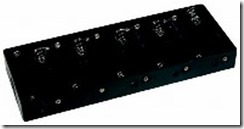
 As you know, we love our Kinect device, but one of the big problems when you want to play with it is that it’s a powered device which means you need to be close to power, or have a really long extension cord which isn’t always convenient. We decided we wanted to make a battery pack so we can take it and and our laptop and not be tied to needing a power point nearby. To build it we had a few criteria:
As you know, we love our Kinect device, but one of the big problems when you want to play with it is that it’s a powered device which means you need to be close to power, or have a really long extension cord which isn’t always convenient. We decided we wanted to make a battery pack so we can take it and and our laptop and not be tied to needing a power point nearby. To build it we had a few criteria:
- Cost – something relatively cheap to buy/replenish
- Form factor – something that won’t draw too much attention/questions if we want to take it on a plane
- Easy build – something we (not electrician) can build relatively easy ourselves.
We settled on making a “AA” powered pack. This would draw no questions at airports and won’t be an issue taking on a plane and the added bonus is if it doesn’t work, the batteries can be used in many other devices. This meant for a normal AA we’d need 8 batteries to make 12 Volts! This could get expensive quickly depending on how quickly they go flat so we decided rechargable AA’s would be more practical in the long term. These however, are only 1.2 V so we needed 10 of them.
Next I wanted to be able to plug back into mains, or car etc if we needed rather than being tied permanently to the battery pack. So we went to JayCar and got a few bits and pieces that satisfied our needs. We ended up with:
 – Kinect for Windows device
– Kinect for Windows device – Exisiting Power plug for the Kinect (we had a US one we could sacrifice happily)
– Exisiting Power plug for the Kinect (we had a US one we could sacrifice happily) – PH9210 10xAA Side by Side holder
– PH9210 10xAA Side by Side holder – PP0510 2.1mm DC Power Line Female Connector – we bought 2 of these – 1 for the battery pack and 1 for the existing power supply so we could swap back if needed
– PP0510 2.1mm DC Power Line Female Connector – we bought 2 of these – 1 for the battery pack and 1 for the existing power supply so we could swap back if needed – PS0526 2.1mm Inline Male DC Power Connector – 1 of these to go on the end of the cable that attaches to the Kinect and the computer.
– PS0526 2.1mm Inline Male DC Power Connector – 1 of these to go on the end of the cable that attaches to the Kinect and the computer.
We cut the existing power cable and discovered it’s a brown/white rather than Black/red. Luckily our favourite search engine was able to tell us that brown is positive and white is ground. John then soldered the cables together and checked the amps etc. using a multimeter. Here’s our completed product (we need to tape everything up and maybe put it in a case):
We tested it first using a Kinect for XBox so I wouldn’t cry as much if it blew up as they are cheaper and much easier to buy in Australia. It all worked great so we did our final test with the Kinect for Windows device hooked to my laptop and I’m happy to say it all worked and survived. We’ll report back on how we go after we road test it and see what sort of up time and success we get from it.

